Il 23 Receptor

Interleukin 23 And Its Receptor Complex Download Scientific Diagram

Interleukin 23 And Interleukin 17 Importance In Pathogenesis And Therapy Of Psoriasis

Figure 1 From The Il 23 Il 17 Axis In Psoriatic Arthritis Semantic Scholar

Interleukin 23 Receptor Il 23r Expression By Donor T Cells Is Not Download Scientific Diagram

Interleukin 23 Subunit Alpha Wikipedia

Scheme Demonstrating The Interaction Of Il 23 Cytokine With Il 23 Download Scientific Diagram
However, it performs differently from IL-12.

Il 23 receptor. IL-23 is a heterodimeric cytokine that shares biological properties with proinflammatory cytokines. However, due to the lack of availability of sensitive Ab reagents specific for the IL-23 receptor (IL-23R), it has been difficult to characterize the cell types that expres … This site needs JavaScript to work properly. Intracellular phosphorylation signaling activates STAT3 molecules, which translocate into the nucleus and upregulate the transcription of cytokines of IL-17A, IL-17F, IL-22, and IFN-γ.
Mouse IL-23 was found not to induce significant amounts of IFN-gamma. Unit of Johnson & Johnson (NYSE:JNJ) exclusive, worldwide rights to co-develop and co-promote PTG-0treat beta thalassemia, for which it has Orphan Drug designation in the U.S. Whereas IL-12 induces development of Th1 cells, which produce interferon-γ, IL-23 is involved in differen ….
IL23 functions in innate and adaptive immunity and may participate in acute response to infection in peripheral tissues. Binds IL23 and mediates T-cells, NK cells and possibly certain macrophage/myeloid cells stimulation probably through activation of the Jak-Stat signaling cascade. IL-23, an IL-12 family member, has been implicated in the development of Th17 cells and the progression of autoimmune diseases.
Interleukin-23 receptor is a type I cytokine receptor. As the IL-12 and IL-23 receptors share a common subunit, it has been assumed that these receptors are co-expressed. Associates with IL12RB1 to form the interleukin-23 receptor.
IL-23 is a cytokine, which is a type of protein that regulates the activity of immune cells. IL-23 mediates it cellular function by binding to IL-23 receptor, which pairs with IL-12Rb1 to confer IL-23 responsiveness. Along with other immune cells, T H 17 produces IL-17.
IL-23 binds to a heterodimeric receptor complex composed of IL12RB1 and IL23R, activates the Jak-Stat signaling cascade, stimulates memory rather than naive T-cells and promotes production of proinflammatory cytokines. Description IL-23R is a 72 kD protein that associates with IL-12RB1 to form a heterodimer. IL-23 receptor is expressed by various innate and adaptive immune cells, including group 3 innate lymphoid cells (ILC3), neutrophils, γδ T cells, Th17 and natural killer T (NKT) cells.
IL23R, also known as IL23 receptor, belongs to the type I cytokine receptor family, Type 2 subfamily. The IL‐23 receptor (IL‐23R) has been found to be associated with small bowel Crohn's disease (CD) in a whole genome association study.Specifically, the rare allele of the R381Q single nucleotide polymorphism (SNP) conferred protection against CD. The mouse IL-23 Receptor complex is comprised of IL-23R and IL-12 receptor beta 1 (IL-12Rβ1) subunits.
Jaime De Leon IL-23 receptor (PTG-0) PTG-100 PTG-300 Johnson. These dimeric cytokines share a subunit, designated p40, and bind to a common receptor chain, IL-12R beta 1. Associates with IL12RB1 to form the interleukin-23 receptor.
IL-23 and IL-12 have different receptors and different effects. Both IL-12 and IL-23 bind to the b1 receptor of T cells and natural killer cells via their shared p40 subunit. IL-23 is composed of the IL-12p40 soluble receptor subunit and a novel cytokine-like subunit related to IL-12p35, termed p19.
Yet, little is known regarding the biology of these receptors. IL-23 induces IFN-γ production from T cells treated with PHA. IL-23 mediates it cellular function by binding to IL-23R, which pairs with IL-12Rb1 to confer IL-23 responsiveness.
When IL-23 binds to its receptor, it triggers a series of chemical signals inside the cell. IL-23 is secreted by activated mouse and human dendritic cells. IL-23R is a 629 aa, novel subunit of the receptor for cytokine IL23A/IL23 which pairs with the receptor molecule IL12RB1/IL12R beta 1and thus take part in IL23A signaling.
The p40 subunit is shared with IL-12. Binds IL23 and mediates T-cells, NK cells and possibly certain macrophage/myeloid cells stimulation probably through activation of the Jak-Stat signaling cascade. IL-23 is a dimeric cytokine composed of the two subunits p19 and p40 (Oppmann et al., 00).
Thus, blocking the IL-23 receptor can prevent activation of STAT3 and naïve T cell differentiation to a Th-17 cell. IL-23 is closely related to IL-12, which is composed of the same p40 subunit plus a distinct p35 polypeptide. Frucht discusses the similarities of IL-12 and IL-23 and the effects that distinguish.
IL-23 has a unique subunit, IL-23p19, and a subunit that is shared with IL-12, IL-12p40 ( 6 );. Receptor complexes are comprised of an IL-12Rβ1 subunit that is completed with the IL-12Rβ2 subunit for IL-12, or the novel subunit IL-23R for IL-23 (5, 6). The role of current biologic therapies in psoriasis predicates on the pathogenic role of upregulated, immune-related mechanisms that result in the activation of myeloid dendritic cells, which release IL-17, IL-23, and other cytokines to activate T cells, including helper T cell T H 17.
This role is supported by the identification of IL-23 receptor (IL-23R) susceptibility alleles associated with inflammatory bowel disease, psoriasis, and ankylosing spondylitis. During differentiation of Th17 cells, IL-23 enhances IL-22 expression, which leads to increased expression of the IL-23 Receptor (IL-23R). IL23 functions in innate and adaptive immunity and may participate in acute response to infection in peripheral tissues.
Peptide sequence is <50% identical to other receptors in this region. The IL-23 receptor also shares the IL-12Rβ 1 chain paired to the IL-23R. The high affinity IL-23 receptor derives from the combination of IL-12Rβ1 with a unique IL-23.
The IL-23 receptor complex is composed of IL-23R and IL-12Rβ1 subunits, which are associated with the Jak family members, Jak 2 and Tyk2, respectively. It contains 2 fibronectin type-III domains and is expressed by monocytes, Th1, Th, NK and dendritic cells. The mouse IL-23 Receptor complex is comprised of IL-23R and IL-12 receptor beta 1 (IL-12Rβ1) subunits.
IL23 functions in innate and adaptive immunity and may participate in acute response to infection in peripheral tissues. IL-23 is centrally involved in mediating resistance to anti-TNF therapy in patients with Crohn’s disease and thereby represents a suitable molecular target in anti-TNF refractory disease. Associates with IL12RB1 to form the interleukin-23 receptor.
IL-12 and IL-23 cytokines respectively drive Th1 and Th17 type responses. These two proteins fit together like a lock and key. 1,7 This new class of drugs has been designed to function by binding with high affinity to the p40 subunit, thus preventing its binding at the receptor and the subsequent downstream signaling.
The IL-23R complex can bind IL-23, a cytokine that plays roles in innate and adaptive immunity as well as in autoimmune diseases, eg, by the generation and maintenance of Th17 cells. Cellular receptor expression reportedly includes T cells, natural killer (NK) cells, and NKT cells, with lower levels of IL-23R complexes also found on monocytes, macrophages, and DC. Whereas IL-6 and IL-1β are necessary for induction of Th17 cells, IL-23 is responsible for the maintenance of this T helper cell population and production of IL-17 (1, 4, 18).
Isoform 1 is specifically expressed in NK cells. The receptor for IL-23 is formed by the association of a specific IL-23 receptor (IL23R) and IL-12Rbeta1 , which is shared with the receptor for IL-12 (Parham et al., 02). The cytoplasmic region of IL-23 R has three potential Src homology 2 domain-binding sites and two potential Stat-binding sites.
The aim was to examine the association of IL‐23R with. A receptor for the heterodimeric cytokine IL-23 is composed of IL-12Rbeta1 and a novel cytokine receptor subunit, IL-23R. The receptor … Produced in response to a variety of pathogenic organisms, interleukin (IL)-12 and IL-23 are key immunoregulatory cytokines that coordinate innate and adaptive immune responses.
Neutralization of the IL-23 receptor is a promising approach for psoriasis management as the IL-23 is only present on developing Th17 cells. Indeed, the receptors for each appear to share one subunit, but also have at least one distinct subunit. IL-23 R has a WQPWS sequence in the transmembrane-proximal cytokine receptor domain similar to the cytokine receptor signature WSXWS motif.
This proinflammatory cascade results in keratinocyte. Biological activities of mouse IL-23 are distinct from those of mouse IL-12. Despite residual binding of IL-23 (and possibly of IL-12 to an even lower extent), complete IL-12 and IL-23 receptor defects in P therefore result at least in part from the impairment of IL-12 and IL-23 binding to heterodimers comprising the mutant IL-12Rβ1 chains at the cell surface.
A functional receptor for IL-23 (the IL-23 receptor) has been identified and is composed of IL-12R β1 and IL-23R. Our data do not exclude the possibility that the mutant IL. The IL-23R complex is expressed on T cells and ILCs and regulates production of IL-17 (Th17, see below).
In addition, IL-23 plays a key role in the pathogenesis of autoimmune and chronic inflammatory disorders. Interleukin-23 (IL-23) is a heterodimeric cytokine composed of an IL12B (IL-12p40) subunit (that is shared with IL12) and the IL23A (IL-23p19) subunit. IL-23 plays a crucial role in the development and maintenance of T helper 17 cells.
IL-23 regulates various functions of the responding cells critical for host. IL-23 is part of IL-12 family of cytokines. IL-23 is a heterodimeric cytokine that shares biological properties with proinflammatory cytokines.
Interleukin (IL)-23, a member of the IL-12 family, is known to play an important role for the induction and maintenance of T-helper cell 17 (Th17), the production of the downstream IL-17 by the Janus kinase signal transducers 2 and activator of transcription 3 (JAK2/ STAT3) signaling pathway.5-8 Its receptor, the IL-23 receptor (IL-23R). At the cell surface, the IL-23 receptor interacts with a protein called IL-23. IL-23 is one of the main inducers of the expression and production of IL-22 (Kastelein et al., 07).
IL-23 interacts with IL-12Rbeta1 and an additional, novel beta2-like receptor subunit with STAT4 binding domain, termed IL-23R. The IL-23R complex can bind IL-23, a cytokine that plays roles in innate and adaptive immunity as well as in autoimmune diseases, eg, by the generation and maintenance of Th17 cells. Since expression levels of the IL-23 receptor are likely to be much lower than those of IL-23, an anti-IL-23 receptor antibody might offer greater promise in inhibiting the IL-23-IL-17 pathways.
The dimeric receptors for IL-12 and IL-23 contain a common IL-12Rβ1 chain plus unique subunits IL-12Rβ2 or IL-23R. It is unknown whether IL‐23R is associated with IBD in children. Interleukin-23 (IL-23) is a pro-inflammatory cytokine composed of two subunits, p19 and p40.
It acts by binding to a receptor complex consisting of the IL-12 receptor β1 (IL-12Rβ1) and the IL-23 receptor (IL-23R) leading to the activation of signal transducer and activator of transcription 3 (STAT3). IL23R is the name of its human gene. It is a ligand for IL-23 and stimulates T, NK and some myeloid cells.
The receptor for IL-23 is constitutively associated with Jak2 (Janus kinase 2) and predominantly activates Stat3, with less Stat4 activation than IL-12. IL-23 is composed of the IL-12p40 soluble receptor subunit and a novel cytokine-like subunit related to IL-12p35, termed p19. Zou J, Presky DH, Wu CY, Gubler U Differential associations between the cytoplasmic regions of the interleukin-12 receptor subunits beta1 and beta2 and JAK kinases.
Synthetic peptide corresponding to Human IL-23R aa 59-87 (N terminal). The IL-23 receptor (IL-23R) contains all intracellular signaling domains and an Ig domain, but is lacking the 3 membrane-proximal FNIII domains and instead contains a long peptide that connects it to the transmembrane region, similar to IL-6Rα. Surprisingly, we find that the expression of each of these receptors is restricted to specific cell types, in both mouse and human.
The company’s remaining pipeline includes PTG-0, an oral IL-23 receptorBiotech Inc. IL-23 is another heterodimeric type I cytokine. The cytoplasmic region of IL-23 R has three potential Src homology 2 domain-binding sites and two potential Stat-binding sites.
It is composed of two disulfide-linked polypeptide chains, p19 and IL-12 p40. IL-23 R has a WQPWS sequence in the transmembrane-proximal cytokine receptor domain similar to the cytokine receptor signature WSXWS motif. IL23R associates with IL12RB1 to form the interleukin-23 receptor.
PTG-100 is an oral integrin alpha(4)beta(7) antagonist. The interleukin-23 receptor (IL-23R) is composed of IL-23R and IL-12Rβ1 subunits, which is shared with IL-12R ( 1).IL-23/IL-23R is essential for the T-helper 17 (Th17) cell-mediated immune response ( 2, 3).Th17 cells are a recently discovered proinflammatory CD4 + effector T-cell population that contributes to pathogen clearance and tissue inflammation by expressing high levels. It is necessary for generation of Th17 cells but is not required for maintenance of previously generated Th17 cells.
Binds IL23 and mediates T-cells, NK cells and possibly certain macrophage/myeloid cells stimulation probably through activation of the Jak-Stat signaling cascade. Interleukin-23 (IL-23) is a cytokine that belongs to the IL-12 cytokine family that is produced mainly by antigen-presenting cells. The newly discovered cytokine interleukin (IL)-23 shares some in vivo functions with IL-12, including the activation of the transcription factor STAT4 (signal tranducer and activator of transcription-4).
Agonist antibodies to IL-23 receptor Download PDF Info Publication number USB2.

Insights Into Il 23 Biology From Structure To Function Sciencedirect

A Cytokine Network Involving Il 36g Il 23 And Il 22 Promotes Antimicrobial Defense And Recovery From Intestinal Barrier Damage Pnas
Q Tbn 3aand9gctqbfacvjex1xa4zty3a0bxustgicpull Z5fhjpzkkoa 3jhx9 Usqp Cau

Homeostatic Il 23 Receptor Signaling Limits Th17 Response Through Il 22 Mediated Containment Of Commensal Microbiota Pnas

Il 23 A Cytokine That Acts On Memory T Cells Science Signaling

Discovery Of The Il 23 Il 17 Signaling Pathway And The Treatment Of Psoriasis The Journal Of Immunology
Il 23 Signaling Regulation Of Pro Inflammatory T Cell Migration Uncovered By Phosphoproteomics

A Cytokine Network Involving Il 36g Il 23 And Il 22 Promotes Antimicrobial Defense And Recovery From Intestinal Barrier Damage Pnas

Anti Il 23 Receptor Antibody Clone Oti5h9 Precisionab Monoclonal Antibody Bio Rad

Il 23r Products R D Systems

Il23 Receptor Protein Overview Sequence Structure Function And Protein Interaction Sino Biological
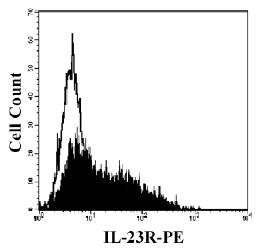
Anti Il23r Antibody Mouse Anti Human Monoclonal Pe Flo Lsbio
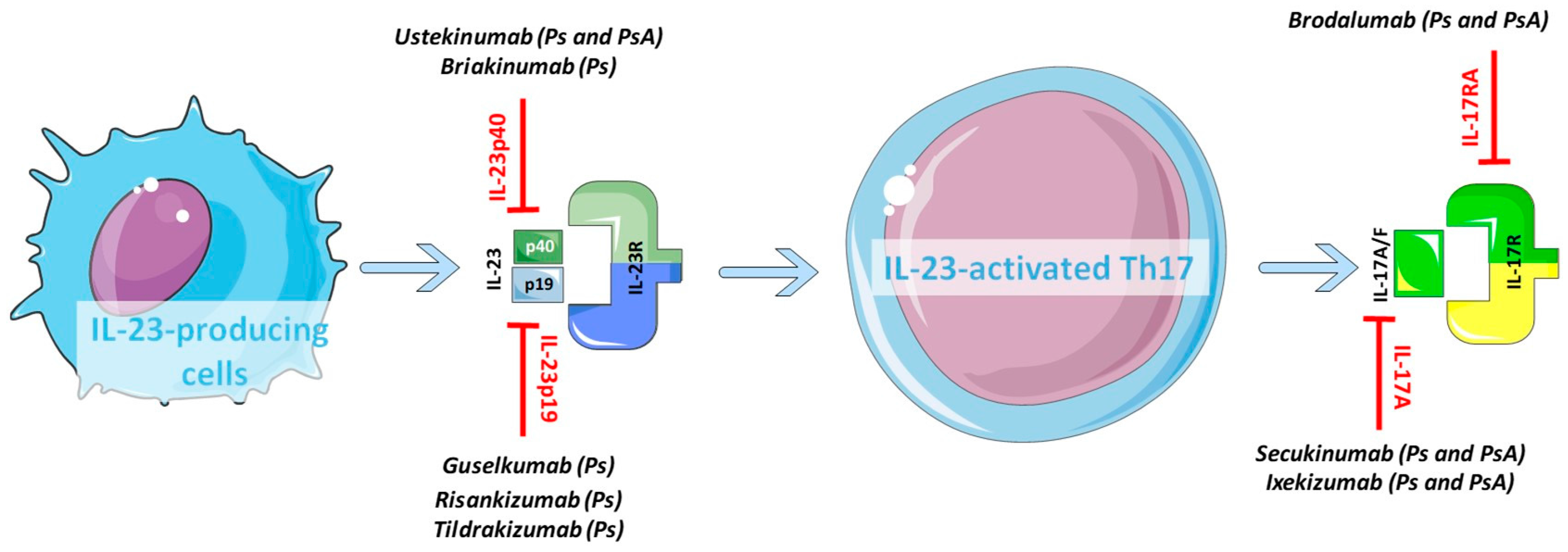
Ijms Free Full Text Role Of The Il 23 Il 17 Axis In Psoriasis And Psoriatic Arthritis The Clinical Importance Of Its Divergence In Skin And Joints Html

A Receptor For The Heterodimeric Cytokine Il 23 Is Composed Of Il 12rb1 And A Novel Cytokine Receptor Subunit Il 23r The Journal Of Immunology

A Receptor For The Heterodimeric Cytokine Il 23 Is Composed Of Il 12rb1 And A Novel Cytokine Receptor Subunit Il 23r The Journal Of Immunology

Regulation Of The Il 23 And Il 12 Balance By Stat3 Signaling In The Tumor Microenvironment Abstract Europe Pmc

Il 23 And Il 1b Drive Human Th17 Cell Differentiation And Metabolic Reprogramming In Absence Of Cd28 Costimulation Cell Rep X Mol

Correlation Between Interleukin 23 Receptor Gene Polymorphisms And Risk Of Hepatitis B Virus Infection In Patients
Q Tbn 3aand9gcqdimc ygfpmlvmj8rzqp0g2bt5yjdneutz3bt Pp4ntru9 Usqp Cau

Soluble Interleukin 23 Receptor Gene Therapy With Adeno Associated Vectors For The Treatment Of Multiple Sclerosis Edo A Espinosa Parrilla Jf Neural Regen Res

Anti Interleukin 23 Receptor Antibody Products Biocompare

Quality Reliable Recombinant Mouse Il 23 Receptor Il 23r Protein Fc At Elabscience Com

Abundant Expression Of The Interleukin Il 23 Subunit P19 But Low Levels Of Bioactive Il23 In The Rheumatoid Synovium Differential Expression And Toll Like Receptor Tlr Dependent Regulation Of The Il23 Subunits P19 And P40
Il 23 Signaling Regulation Of Pro Inflammatory T Cell Migration Uncovered By Phosphoproteomics

Cd4 Ccr6 T Cells But Not Gd T Cells Are Important For The Il 23r Dependent Progression Of Antigen Induced Inflammatory Arthritis In Mice Eur J Immunol X Mol
Il 23 Signaling Regulation Of Pro Inflammatory T Cell Migration Uncovered By Phosphoproteomics
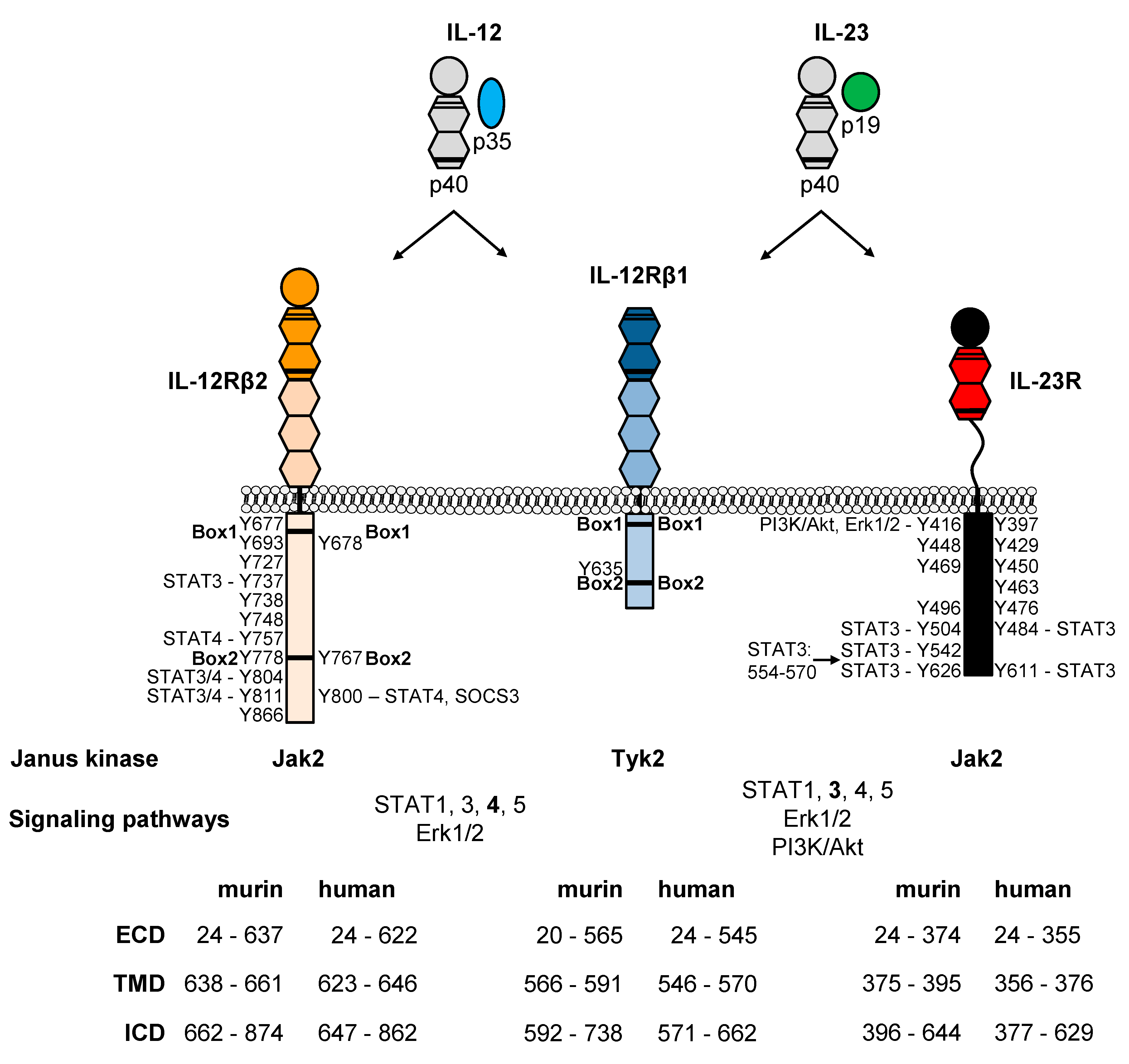
Cells Free Full Text Il 12 And Il 23 Close Relatives With Structural Homologies But Distinct Immunological Functions Html

Structural Activation Of Pro Inflammatory Human Cytokine Il 23 By Cognate Il 23 Receptor Enables Recruitment Of The Shared Receptor Il 12r Bgr 1 Semantic Scholar

Anti Interleukin 23 Receptor Antibody Products Biocompare

Il 12 Il 23 And Il 27 Cytokines And Their Receptors A Il 12 Is A Download Scientific Diagram
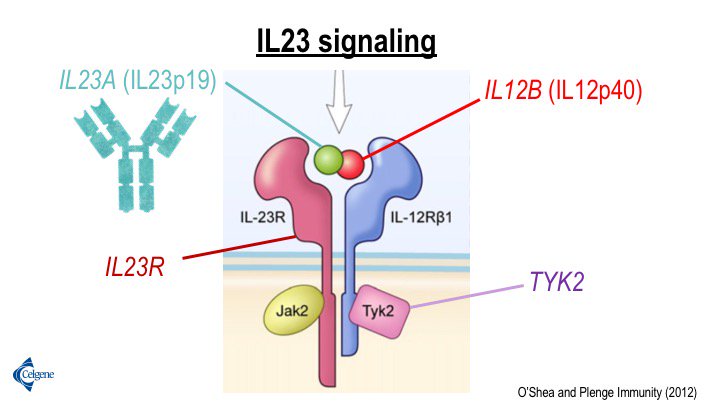
Robert Plenge The Il23 Signaling Pathway In Psoriasis Has Particular Strong Genetic Support Both Subunits Of The Il23 Ligand One Subunit Of The Il23 Receptor And Multiple Intracellular Signaling Molecules

Patent Report Us Cd3 And Il 23 Receptor Binding Bispecific Constructs And Their Use In The Treatment Of Various Diseases
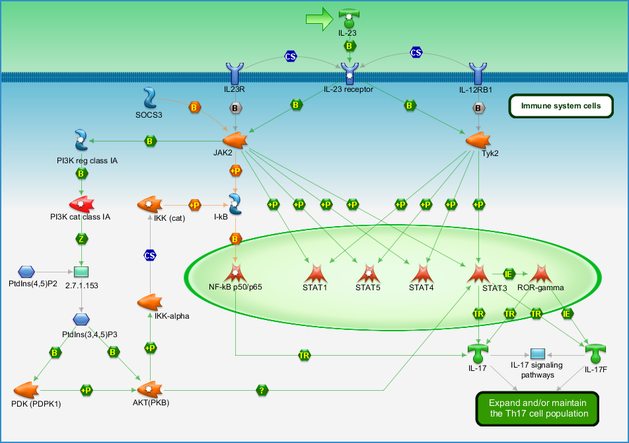
Immune Response Il 23 Signaling Pathway Pathway Map Primepcr Life Science Bio Rad
Rat Anti Mouse Murine Il23r Antibody Alexa Fluor 700 Abin

Il 12 Il 23 And Il 17 In Ibd Immunobiology And Therapeutic Targeting Nature Reviews Gastroenterology Hepatology
Http Michnick m Umontreal Ca Publications Pdfs 14 5 Pdf
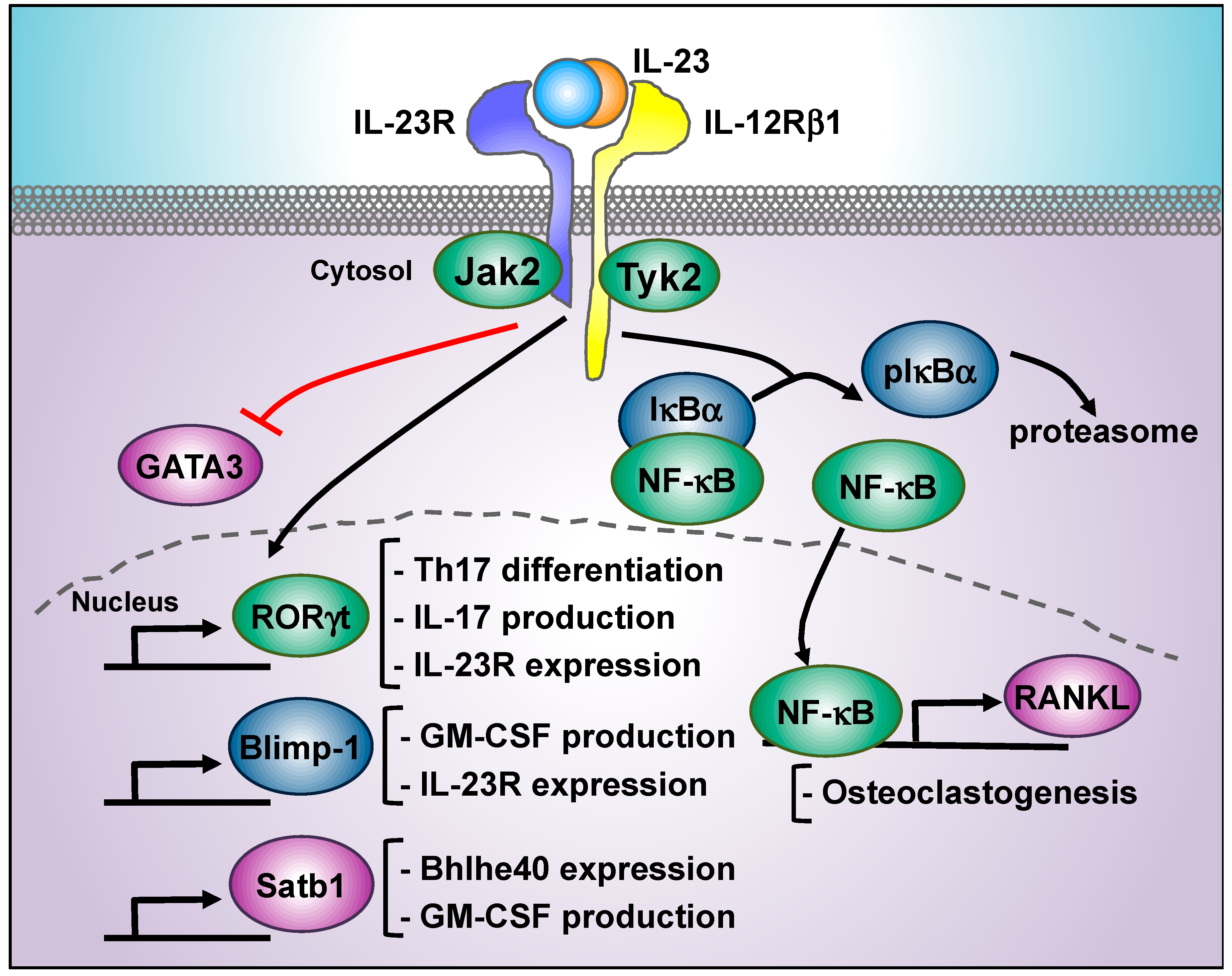
Cells Free Full Text Decoding Il 23 Signaling Cascade For New Therapeutic Opportunities

Rbpj Controls Development Of Pathogenic Th17 Cells By Regulating Il 23 Receptor Expression Sciencedirect

Anti Il 23 And Anti Il 17 Biologic Agents For The Treatment Of Immune Mediated Inflammatory Conditions Frieder 18 Clinical Pharmacology Amp Therapeutics Wiley Online Library

Il 23r Antibody Nb600 1147 Novus Biologicals
Plos One Protection Against Th17 Cells Differentiation By An Interleukin 23 Receptor Cytokine Binding Homology Region

Il23 Receptor Protein Overview Sequence Structure Function And Protein Interaction Sino Biological

Cell Line Of The Month Il 23

Il 23 Promotes The Development Of Castration Resistant Prostate Cancer Yan 18 Immunology Amp Cell Biology Wiley Online Library
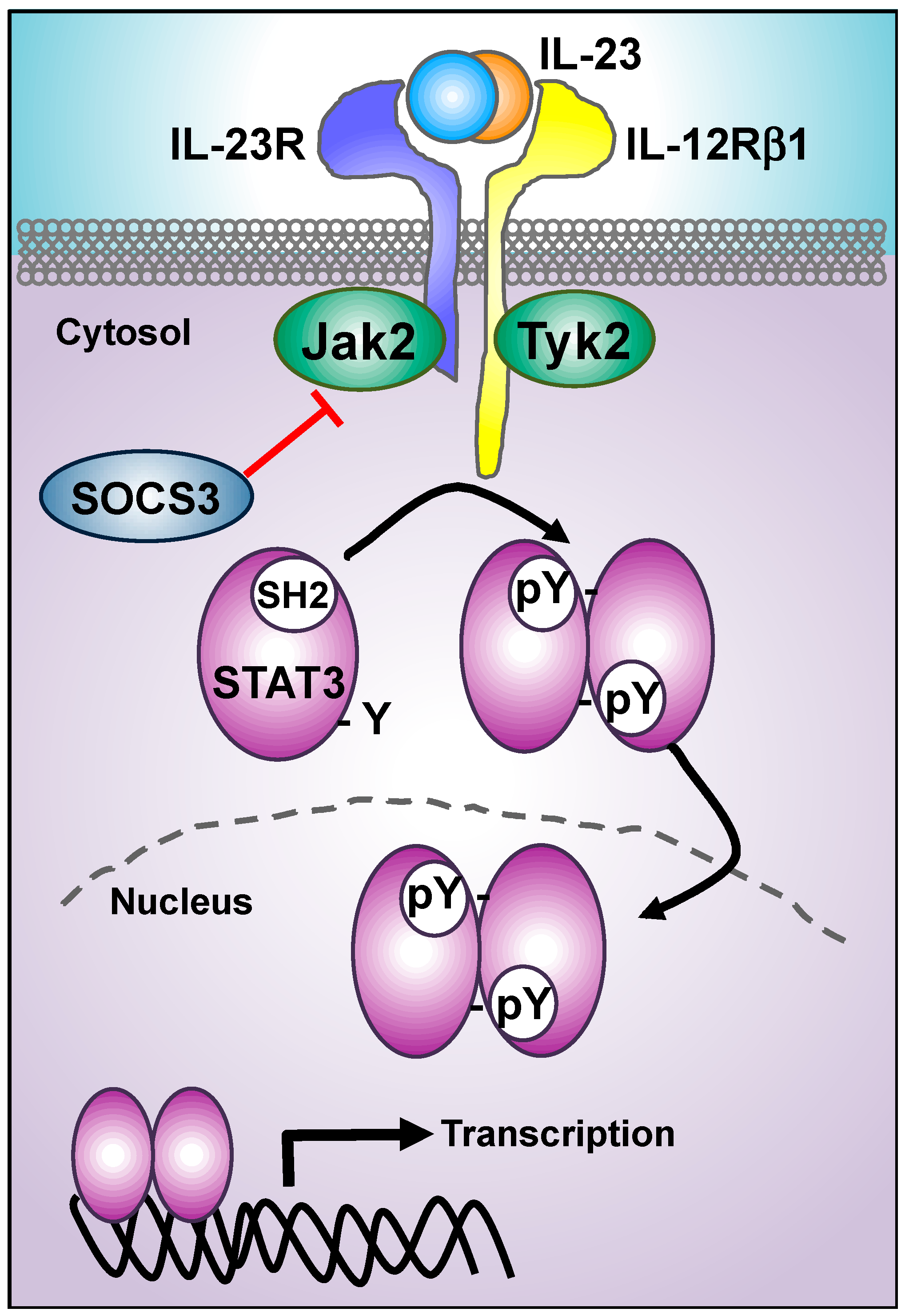
Cells Free Full Text Decoding Il 23 Signaling Cascade For New Therapeutic Opportunities

Frontiers Transcription Factor Retinoid Related Orphan Receptor Gt A Promising Target For The Treatment Of Psoriasis Immunology

Human Interleukin 23 Receptor Il 23r Elisa Kit Cusabio

Microenvironmental Regulation Of The Il 23r Il 23 Axis Overrides Chronic Lymphocytic Leukemia Indolence Science Translational Medicine

Frontiers Interleukin 22 Signaling In The Regulation Of Intestinal Health And Disease Cell And Developmental Biology
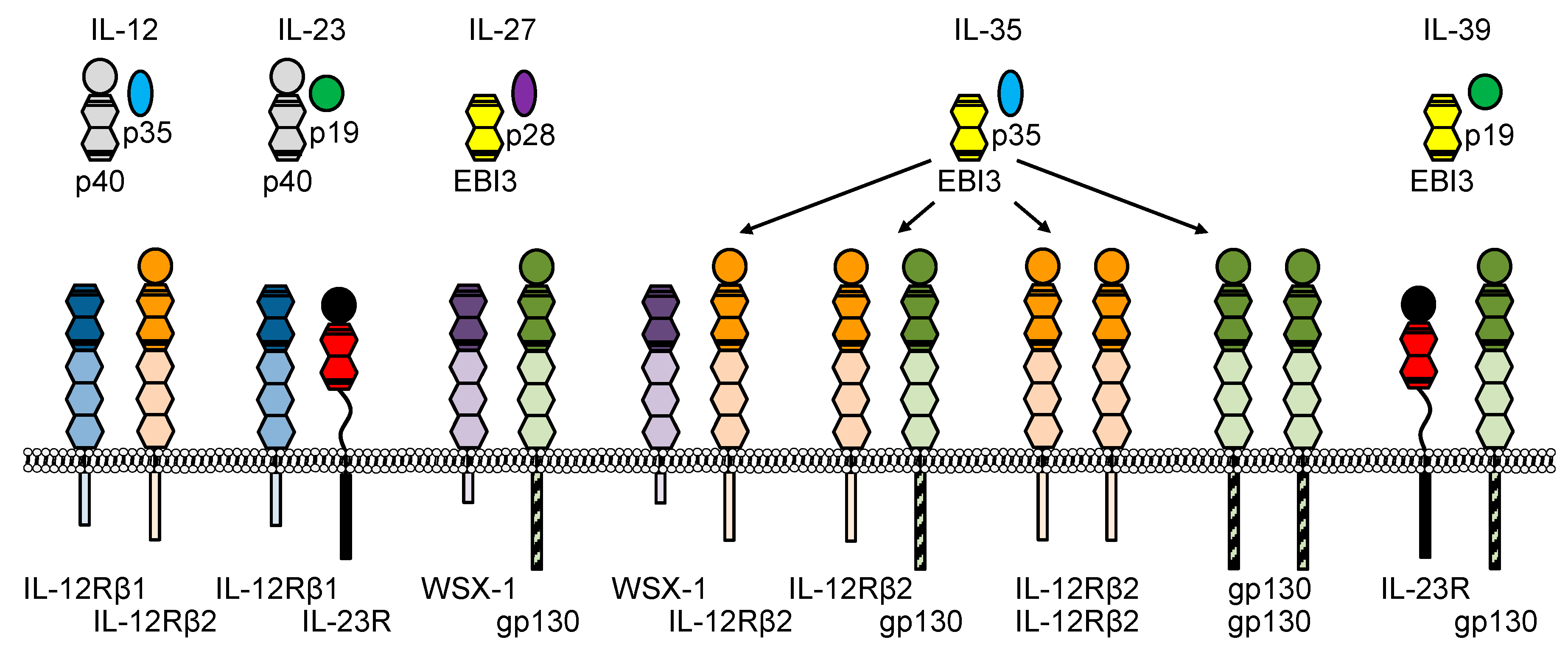
Cvmiazoontemqm

Rbpj Controls Development Of Pathogenic Th17 Cells By Regulating Il 23 Receptor Expression Topic Of Research Paper In Biological Sciences Download Scholarly Article Pdf And Read For Free On Cyberleninka Open Science

Fig 1 Key Opinions In Medicine

The Il 23 Axis Genes Associationed With Psoriasis Il 12 And Il 23 Share Download Scientific Diagram

Il 23 Promotes Tcr Mediated Negative Selection Of Thymocytes Through The Upregulation Of Il 23 Receptor And Rorgt Nature Communications
Q Tbn 3aand9gcsyddolyfjahkrlafzrifazci2kbymbcx4o4jp4bfjulqyevxq9 Usqp Cau

A Receptor For The Heterodimeric Cytokine Il 23 Is Composed Of Il 12rb1 And A Novel Cytokine Receptor Subunit Il 23r The Journal Of Immunology

Il 23 A Promising Target Or Have We Been There And Done That Multiple Sclerosis Research Blog

Interleukin 12 Il 12 And Il 23 Signal Transduction Pathways Il 12 Download Scientific Diagram

Anti Il23 Receptor Il23r Antibody Picoband Bosterbio

Elisa For Diagnosis Of Crohn S Disease Serological Detection Of Il 23 Receptor Variants

A Receptor For The Heterodimeric Cytokine Il 23 Is Composed Of Il 12rb1 And A Novel Cytokine Receptor Subunit Il 23r The Journal Of Immunology

Interleukin 23 As A Therapeutic Target For Inflammatory Myopathy Scientific Reports

Il 23 Signaling Pathway Il 23 Is A Heterodimeric Cytokine Composed Of Download Scientific Diagram

Il 12 Family Cytokines Receptors And Signaling Pathways Il 12 Download Scientific Diagram

Subduing The Rebellion Unmasking Rogue Cells In The Immune System Eurekalert Science News

Structural Activation Of Pro Inflammatory Human Cytokine Il 23 By Cognate Il 23 Receptor Enables Recruitment Of The Shared Receptor Il 12rb1 Sciencedirect

R Human Il 23r m Versaclone Cdna 10µg Life Sciences Fisher Scientific

A Balance Of Interleukin 12 And 23 In Cancer Trends In Immunology

Il 23 Induces Human Osteoclastogenesis Via Il 17 In Vitro And Anti Il 23 Antibody Attenuates Collagen Induced Arthritis In Rats Arthritis Research Therapy Full Text

Interleukin 23 Wikipedia

Interleukin 12 Wikipedia
2

The Il 23 Il 17 Immune Axis From Mechanisms To Therapeutic Testing Nature Reviews Immunology

Interleukin 22 Receptor 1 Is Expressed In Multinucleated Giant Cells A Study On Intestinal Tuberculosis And Crohn S Disease

Human Il 23 Receptor Biomolecules Biocompare

Figure 1 Generation Of Th17 Cells Transforming Growth Factor B And Il 6 Initiate Th17 Differentiation Th17 Cells Produce Il 21 Which Amplifies Th17 Generation And Induces Expression Of Il 23 Receptor Il 23 Stabilizes The Th17 Phenotype By Secreting Il

Interleukin 23 Inhibition As A Strategy To Treat Immune Mediated Inflammatory Diseases European Medical Journal

Il 12 Il 23 And Il 17 In Ibd Immunobiology And Therapeutic Targeting Nature Reviews Gastroenterology Hepatology

Stat3 And Nf Kb Signal Pathway Is Required For Il 23 Mediated Il 17 Production In Spontaneous Arthritis Animal Model Il 1 Receptor Antagonist Deficient Mice The Journal Of Immunology

Janssen J J Expands Its Ptg 0 Collaboration With Protagonist For Second Generation Oral Il 23 Receptor Antagonists Pharmashots

Figure 5 From Genetic Variations In The Interleukin 12 Interleukin 23 Receptor B1 Chain And Implications For Il 12 And Il 23 Receptor Structure And Function Semantic Scholar

T Helper 17 Cells In Psoriatic Plaques And Additional Genetic Links Between Il 23 And Psoriasis Sciencedirect

Anti Il23r Antibody Rabbit Il23 Receptor Polyclonal Antibody Np 2

The Molecular Basis Of Chaperone Mediated Interleukin 23 Assembly Control Nature Communications

Interleukin 23 And Autoimmune Diseases Current And Possible Future Therapies Springerlink

New Mechanisms And Expanded Indications For Biologic Therapies

Interleukin Il 12 And Il 23 Structure And Receptors Notes The Il 12 Download Scientific Diagram

Interleukin 23 Represses The Level Of Cell Senescence Induced By The Androgen Receptor Antagonists Enzalutamide And Darolutamide In Castration Resistant Prostate Cancer Cells Springerlink

Insights Into Il 23 Biology From Structure To Function Sciencedirect
-Western-Blot-NBP2-27091-img0004.jpg)
Il 23r Antibody 15n6c6 Nbp2 Novus Biologicals

Anti Il 23r Antibody Cytoplasmic Clone From Rabbit Purified By Affinity Chromatography Sigma Aldrich
Plos One Polymorphisms In The Toll Like Receptor And The Il 23 Il 17 Pathways Were Associated With Susceptibility To Inflammatory Bowel Disease In A Danish Cohort

Binding Of Rex Variants To Human Cell Lines Correlates Open I
Q Tbn 3aand9gctknda Sihqkqm Fisk5pqk4a5nb Irkeweixmpoesa8 Yqxxu Usqp Cau

Synthetic Deletion Of The Interleukin 23 Receptor Il 23r Stalk Region Led To Autonomous Il 23r Homodimerization And Activation Molecular And Cellular Biology

Association Of Interleukin 23 Receptor Il 23r Gene Variants With Gout And Rheumatic Heart Fever Rhf

Vitamin D Downregulates The Il 23 Receptor Pathway In Human Mucosal Group 3 Innate Lymphoid Cells Journal Of Allergy And Clinical Immunology

Interleukin 17 Producing T Helper Cells And Related Cytokines In Human Airways Exposed To Endotoxin European Respiratory Society



